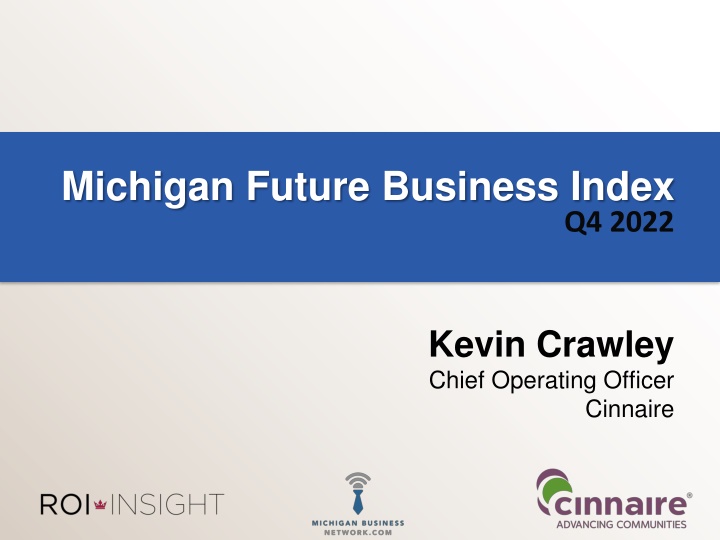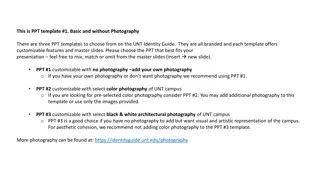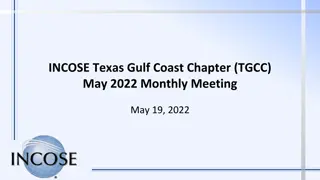
Michigan Future Business Index Q4 2022 Insights by Kevin Crawley
Discover key takeaways from the Michigan Future Business Index Q4 2022 report by Chief Operating Officer Kevin Crawley. Learn about wage inflation trends, supply chain challenges, and business outlook for the next six months based on a statewide survey of small to medium-sized businesses in Michigan.
Download Presentation

Please find below an Image/Link to download the presentation.
The content on the website is provided AS IS for your information and personal use only. It may not be sold, licensed, or shared on other websites without obtaining consent from the author. If you encounter any issues during the download, it is possible that the publisher has removed the file from their server.
You are allowed to download the files provided on this website for personal or commercial use, subject to the condition that they are used lawfully. All files are the property of their respective owners.
The content on the website is provided AS IS for your information and personal use only. It may not be sold, licensed, or shared on other websites without obtaining consent from the author.
E N D
Presentation Transcript
Michigan Future Business Index Q4 2022 Kevin Crawley Chief Operating Officer Cinnaire
Michigan Future Business Index Methodology Statewide survey of 923 small to medium-sized businesses; 750 completed the survey Mixed-mode survey, conducted online and by phone Commissioned by Cinnaire & Michigan Business Network Conducted by ROI Insight Field Dates: November 21 through December 31, 2022
Key Takeaways The wage inflation stressor is growing, as overall inflation continues to impact profits. However, supply chain challenges are subsiding. Inflation remains the number one challenge to doing business, but wage inflation is climbing the list, impacting profits and hiring. Sales and profits over the past six months beat Q2 MFBI projections, but uncertainty over business costs and the economy is restraining optimism for the next six months. Hiring projections slow as wage inflation eats into profits. More than 4 in 10 say they ve fully recovered from the COVID-19 pandemic and comments to open-end questions indicate fears of long- term inflation and a recession are easing. The next six months will be critical in setting the stage for business success over the next decade.
The Past Six Months While the percentage of those reporting hiring and profit increases are up slightly since Q2, the share of those reporting higher wages and sales has held steady. All met or beat Q2 MFBI projections. Wage increases holding steady at record level More than six in ten (62%) say their employee wages have increased in last six months, representing no change since Q2. Sales increases holding steady since Q2 Four in ten (40%) say sales have increased in the last six months. Profit increases ticked up slightly since Q2 One quarter (25%) report profit increases, up two points since Q2. Hiring ticked up slightly, while layoff decreased slightly Those reporting new hires up one point to 22% since Q2 Investments down one point Increased capital investments (24%) outpace decreases (13%)
Trending The Indicators: Wages 4%5% Past Six Months 29% Wages Increase Stay Same Decrease DNA 62 62 62% 59 53 4850 46 46 44 4442 43 43 40 37 36 30 2725 27 COVID-19 14 15 Wage inflation remains record high levels
Trending The Indicators: Sales Past Six Months 49 49 50 49 48 45 46 45 44 43 3840 41 42 4240 40 40 40 4% 3335 32 21% Increase Stay Same Decrease DNA 40% Sales Those reporting a decrease in sales up 3 points from June COVID-19 35%
Trending The Indicators: Profits 1% 25% Past Six Months 39% Profits Increase Stay Same Decrease DNA 35% 38 37 35 3432 3331 32 30 31 292729 29 30 27 252325 21 22 21 COVID-19 Profit increases up slightly, decreases down one point since June.
Trending The Indicators: Number of Employees 3% Past Six Months 22% 17% Increase Stay Same Decrease DNA Employees 3129 3032 58% 28 27 25 26 25 25 22 21 22 201820 21 22 COVID-19 20 21 12 11 Those reporting a decrease in employees continues to drop, down 3 points from June
Trending The Indicators: Capital Investments Past Six Months 21% 24% Equip- ment/ Facilities Increase Stay Same Decreased DNA 15% 28 28 29 28 40% 25 26 2725 2527 27 25 24 21 22 22 22 20 19 19 18 19 COVID-19 June '11 June '12 June '14 June '15 June '16 June '18 June '19 June '21 June '22 Nov'15 Nov '14 Nov '16 Nov '17 Nov '18 Nov '19 Nov '21 Nov '22 Oct '11 Oct '12 May '13 Nov '13 July '17
Satisfaction with Economy Satisfaction with the business economy continues its downward slope. The percentage of those saying they are dissatisfied with the economy increased one point since Q2 to 56%; 36% somewhat dissatisfied and 20% very dissatisfied Up from 52% dissatisfied one year ago 44% say they are satisfied with the economy; 36% somewhat and 8% very satisfied Down from 48% one year ago Very dissatisfied outpacing very satisfied now more than 2 to 1 Retail/Food Service (51%) and Business & Professional Services sectors (49%) are now most likely to be satisfied with the economy, while Insurance/Finance/Real Estate (64%) and Non-Profit/Health Care (61%) sectors are most dissatisfied, which is a flip from Q2.
Satisfaction with Economy Trends As it Affects Your Business 84 82 82 81 82 81 80 80 79 78 77 76 76 73 71 70 69 69 67 66 67 66 66 62 56 57 55 56 54 55 55 Dissatisfied Satisfied 52 52 48 48 45 44 44 43 43 41 34 34 32 32 31 29 29 29 29 28 27 COVID-19 22 20 21 20 19 18 19 18 18 18 17 15 14 11
Greatest Challenges To Doing Business Inflation remains the top challenge. Wage inflation climbs to third place. Since Q2 22 Nov 2019 June 2021 Nov 2021 June 2022 Nov 2022 Inflation 23% 29% 52% 52% No Change Acquiring Talent 46% 49% 45% 46% 41% -5 Wage Inflation 19% 27% 23% 24% 32% +8 +1 Retaining Talent 25% 26% 23% 24% 25% -11 Supply Chain Challenges 34% 35% 24% Cost of Health Insurance 40% 25% 25% 19% 24% +5 Finding Customers 28% 22% 17% 14% 21% +7 Taxes 23% 17% 17% 12% 16% +4 Multiple responses were accepted. Percentages add up to more than 100%. Other Government Regulations 19% 17% 12% 15% +3 Retaining Customers 16% 14% 8% 10% 11% +1 Access to Capital 10% 3% 5% 5% 7% +2 COVID-19 Regulations 19% 23% 11% 5% -6
Concern About Inflation Continues To Climb, But Intensity Is Softening 74% Concerned +4 Since Q4 2021, +1 Since Q2 2022 47% 27% 18% 6% 2% 53% 20% 14% 7% 6% 47% 23% 19% 6% 6% 40% 27% 3 20% 8% 6% 1 - Extremely Concerned 2 4 5 - Not Concerned At All 0% 20% 40% 60% 80% 100%
Greatest Reasons for Optimism Optimism for Opportunity, Demand, Innovation Since Q2 22 Q4 2019 Q2 2021 Q4 2022 Q2 2022 Now Demand For Products/Services 17% 15% 18% 13% 16% +3 Business Growth/Expansion 11% 17% 18% 15% 14% -1 Great Customers 13% 10% 11% 11% 12% +1 +3 +3 My Staff/Team/Employees 7% 7% 6% 9% 12% More Opportunities 6% 8% 5% 5% 8% +3 Flexible/Nimble/Innovative 1% 5% 5% 2% 5% +2 The Economy 10% 8% 3% 3% 5% We Survived/Resilient/Longevity 7% 5% 2% 4% +2 Business Is Good 4% 7% 2% 2% 4% +2 End of COVID-19 Pandemic 9% 7% 3% 2% -1 -2 Politics/Hope For Reforms 5% 4% 5% 4% 2%
Emerging From Covid How Is Your Business Doing Now? Pretty good/Excellent Not so good/Poor Just Okay/Surviving 90% 81% 77% 80% 70% 60% 51% 50% 49% 50% 43% 42% 40% 34% 33% 33% 27% 31% 30% 24% 18% 27% 15% 20% 24% 16% 15% 10% 4% 8% 0% Pre COVID-19 Q2 2020 Q4 2020 Q2 2021 Q4 2021 Q2 2022 Q4 2022
Emerging From COVID-19 When do you expect to fully recover? -8 Since November 13% +7 Already Fully Recovered By Q2 2023 44% 18% By Q4 2023 2024 or later Not Sure I Will Ever Recover 15% 10%
Sales & Profit Projections Continue to Slump Percentages of those projecting sales and profit increases continue on a downward trajectory since Q2 2021. Projections for decreased profits remain at an MFBI record level (27%), up 14 points from one year ago. Projected sales growth at 45% down eight points from one year ago. Expectations for sales decreases reaches a record level (17%). Twenty-seven percent (27%) expect profits to continue to decline in the next six months. The percentage of those believing profits will increase is now nearly equal to those believing they will stay the same. Expectations for sales growth is now highest in the Business/Professional Services sector (53%) and lowest in the Non-Profit/Health Care sector (36%). Profit increases are most expected in the Business/Professional Services sector (42%) and lowest in the Retail/Food Service sector (28%)
Projected Sales Trends Over The Next Six Months ... 68 66 63 62 62 61 61 60 60 59 58 57 57 53 50 50 48 Increase Decrease No Change 45 44 43 40 42 40 39 40 38 37 37 35 34 33 32 32 32 31 30 30 29 29 28 26 26 26 COVID-19 25 17 16 13 13 11 11 10 9 8 7 7 7 6 6 6 5 5 5 5 4 3 3
Projected Profit Trends Over The Next Six Months ... 58 56 56 54 54 53 53 52 50 50 49 49 45 Increase Decrease No Change 44 43 41 40 39 40 40 37 39 39 35 38 37 37 33 36 36 36 35 35 35 34 34 33 33 32 32 32 32 31 30 27 27 22 21 20 20 COVID-19 17 16 16 15 11 11 10 10 9 9 8 8 8 8 7 7
Hiring Continues To Slow Nearly half (48%) of respondents say they will maintain current staffing levels, while four-in-ten (40%) say they plan to hire more employees. The percentage of those saying they are hiring is down nine points from one year ago. The share of those projecting a decrease in employees reaches a level not seen since 2013. Forty percent (40%) say they plan to hire more employees over the next six months. This is the second consecutive MFBI indicating a hiring slowdown. Forty-eight percent (48%) will maintain staff at current levels, up six points from Q4 2021. 8% now say they plan to lay off employee, which is up three points from Q4 2021 and up five points from Q2 2022. The Non-Profit/Health Care sector (49%) is most likely to be hiring in the next six months. The Insurance/Finance/Real Estate sector is most likely to be losing employees in the next six months (12%).
Projected Hiring Trends 74 74 73 71 70 69 68 68 68 65 61 60 60 60 59 58 58 57 57 57 56 56 55 54 53 53 50 49 48 48 46 44 Lay-off Hire Maintain 44 42 41 40 40 39 38 37 37 36 34 34 34 33 31 30 29 26 24 COVID-19 19 18 17 13 16 16 16 15 14 14 14 13 11 12 12 11 10 10 10 10 10 9 9 8 8 8 7 6 6 5 5 5 4 4 4 4 4 4 4 3 3 3 May '06 Nov '06 May '07 Nov '07 Nov '08 Jan '10 Nov '14 Nov '15 Nov '16 Nov '17 Nov '18 Nov '19 Nov '21 Nov '22 Apr '08 Apr '09 Nov '13 July '17 May '13 Oct '10 June '11 Oct '11 June '12 Oct '12 June '14 June '15 June '16 June '18 June '19 June '21 June '22
Nearly Two-In-Three Continue to Report a Lack of Job Applicants No change from Q2, 63% rate their access to qualified talent as only fair or poor. Only 29% say it s pretty good or excellent. Nearly two-thirds 64% are still having difficulty filling open jobs. Up two points from a year ago, 82% of those actively searching for talent are having difficulty. 42% attribute that difficulty to a lack of any applicants down 15 points from a year ago 48% attribute it to a lack of qualified applicants up 19 points from a year ago and back on top, indicating a shift in the labor market. Most say they are keeping the positions open, training less qualified applicants or using temp agencies to fill positions.
Wage Inflation Continues to Set Records Reminder: earlier in the survey, a record share (62%) said they ve already raised wages in the past six months and wage inflation is now the third most significant challenge (32%) to doing business in Michigan. Nearly half (46%) say they will continue to raise wages in the next six months, another near-record result. Projections for wage growth are strongest in the Insurance/Finance/Real Estate sector (55%).
Projected Wage Trends 78 78 76 75 73 72 70 69 68 68 67 67 65 63 63 62 62 58 58 55 53 53 53 53 53 52 52 51 45 Not Increasing Wages Increasing Wages 49 46 49 46 48 47 42 42 41 40 40 38 38 35 35 35 34 34 32 30 28 28 COVID-19 26 24 24 22 20 20 20 18 17 14 13 * Only 0.7% Decreasing Wages Nov '13 Nov '06 Nov '07 Nov '08 Apr '09 Oct '10 Oct '11 Oct '12 Nov '14 Nov '15 Nov '16 Nov '17 Nov '18 Nov '19 Nov '21 Nov '22 Jan '10 July '17 May '06 May '07 Apr '08 May '13 June ' 12 June '11 June '14 June '15 June '16 June '18 June '19 June '21 June '22
Projected Investments & Growth A majority (61%) plan to invest in employee training within the next 6 months up two points from one year ago. More than half (52%) will invest in advertising up two points from one year ago. Nearly one quarter (25%) plan to invest in new equipment down one point from a year ago. Over one-third (35%) plan to add a new product line or service up one point from one year ago.
Conclusions: Inflation worries continue, but the Q4 2022 MFBI indicates that fears of a long recession are softening. The data indicates that wage inflation is making a more significant impact on profitability and hiring. Satisfaction with the economy continues to slump. Sales and profits for the last six months exceeded expectations of the Q2 2022 MFBI. However, small business is cautious regarding projections for the next six months. They see reasons for optimism (growth, demand, opportunity) but the economy and labor market continue to cause uncertainty. Hiring slows as wage inflation eats into profits. Job creators indicate that they re again focused on ROI when hiring.
Conclusions: While the intensity has cooled slightly, most still believe Michigan is a great place to do business with a fair tax system. 62% believe Michigan remains a pretty good (49%) to excellent (13%) market for their business. 62% rate our state business taxes as mostly (56%) to very (7%) fair.
Thank you! We appreciate your interest in the MFBI. For more information or detailed findings, please contact Michigan Business Network. http://www.michiganbusinessnetwork.com 109 E. Oakland Ave. P.O. Box 15279 Lansing, MI 48906 (517) 755-9649












